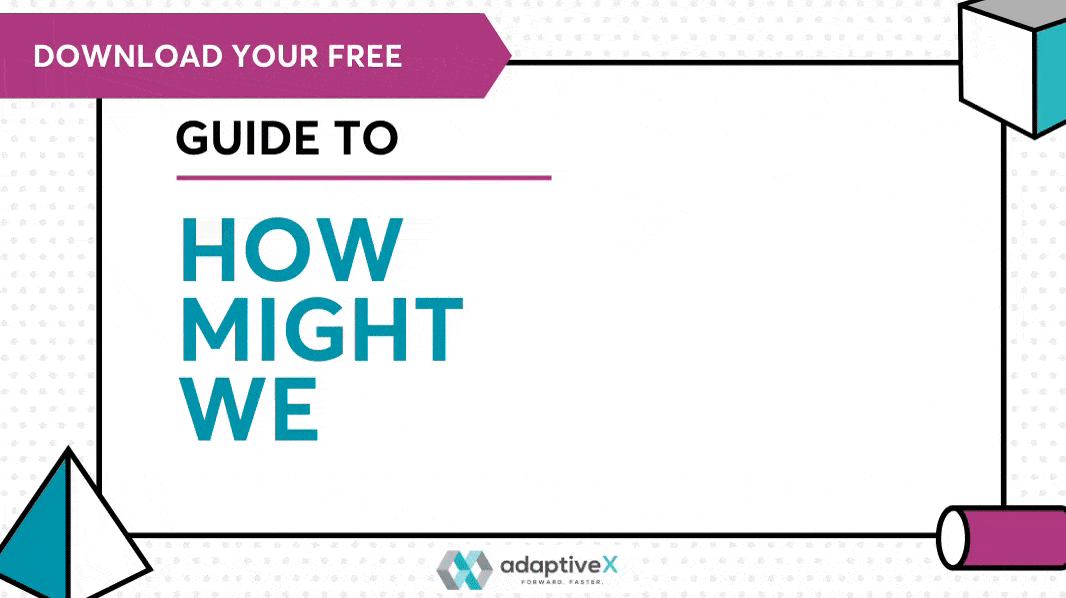Now more than ever, teams and businesses are under a lot of pressure to constantly evolve, innovate, and stay relevant in a time of great uncertainty and major change.
Many of those who’ve been tasked with leading innovation have probably come across, if not dabbled into, design thinking. And while it isn’t the key to unlocking innovative solutions, it isn’t just a powerful tool or a set of practices, it’s a philosophy. It’s a mindset.

Using an iterative approach that’s deeply rooted in empathy, design thinking helps organizations find the “sweet spot” between what delights or satisfies their customer and what meets their business goals. It puts the “customer” at the core of every business decision (and “customer” can mean many different things).
A recent study shows that organizations with a mature design thinking practice achieved a return of investment that ranges between 71% to 107%. It’s no wonder, then, that design thinking has gained rapid interest from executives and senior leaders to team members and individuals alike, in every conceivable industry and sector.
A quick query in any search engine, you’ll find a multitude of articles that describe design thinking and its process. Stanford – one of the most often referred to – offers five different phases in the process: empathy, ideate, define, prototype, and test. At first glance, it may seem linear, or for some, maybe even too structured or constrictive. In reality, design thinking is anything but linear. Once put into practice, teams find themselves moving in and out of the different phases throughout their creative problem-solving process.
Design thinking takes time, commitment and practice to mature and take root in any organization, including learning when it’s an appropriate approach, and when it isn’t. Sometimes it’s hard to wrap your arms around and figure out when it’s effective and how to bring it to life.
We understand how overwhelming it can be, so we suggest by starting out with adopting simple practices. Here are three design practices you can use tomorrow, even remotely, to help you and your team start a more human-centric approach to innovation and growth.
Live through your customer’s perspective
A designer’s mindset is focused on getting a deeper understanding and appreciation for the user’s needs and delivering solutions that fits within their lives. This requires exploration and is the “first” step in the design thinking process.
In order to do that, you must start with empathy. What on earth does that mean? Well, for starters, it means finding ways to look past existing market research and data. Go deeper by adopting empathetic practices, and taking into consideration the feelings, context and varied realities of your target audience.
Step into their shoes and use their voice as if you’re immersing yourself in their world. By doing so, you’ll find ways to provide solutions that work in their context (and remove your own bias in the process).

In a design thinking organization, user interviews are an integral part of their process. They set up in-person testing and conversations to get direct and real-time feedback from their target audience. However, these one-on-one interviews aren’t always possible (or necessary), especially at this point in time, or also if you’re just starting out.
The great thing about technology and social media is that we can engage and observe our users in a variety of ways.
While you may not be able to bring in users to conduct empathy interviews, start with engaging with them online with open-ended questions. Craft questions where respondents can take you through their life and experiences.
So instead of producing binary questions such as: do you like apples or oranges? Consider rephrasing it to something like: how would you identify yourself as a fruit? It piques their interest and helps them to relate their personal stories, which can help you form a holistic picture of their context.
Observation is another critical building block for empathy. What you say and what you do are often not mirror images; in normal pre- (and post-) COVID-19 circumstances, try to find ways to observe the behaviours and patterns of your users over a period of time. This will help you understand your users in ways you often don’t expect; seeing is believing, as they say.
In this time of upheaval and physical distancing, observation – at least in close-proximity ways – isn’t possible, and that’s ok! Explore non-traditional observation approaches wherever possible, or come back to it when it is both recommended and safe to do so (especially if close proximity is required).
Remember, Design Thinking isn’t a linear trajectory. We can move in and out of phases and tools.
Empathy isn’t just the beginning phase, although it is the place to begin. Empathy should be both unabashedly and imperceptibly woven not only throughout your design thinking process, but throughout your organization’s philosophy, up and down and all around.
Reframe your challenges into opportunities
Optimists at our core, we believe the ability to reframe challenges into opportunities is a superpower not only for individuals, but for organizations. It’s a must-have practice in any innovative organization and a skill anyone can learn and develop. From personal experience, and according to practitioners, reframing challenges as opportunities creates a bias for action – one of our absolute favourite design thinking principles.
Design thinking is all about freely moving between ideas and prototypes, iterating and improving throughout the journey. It emphasizes getting started is better than being right (we love that phrase – thanks AJ&Smart!).
In the reframing process, teams move towards a goal instead of being stuck in analysis paralysis to solve a problem. Furthermore, the goal acts as a compass for every team member to contribute their diverse expertise into a holistic approach.
In practice, you can try the “How Might We” exercise. At your next problem-solving meeting, start with exploring all the challenges and pain points relating to your given challenge, and rephrase them into HMW questions. This simple exercise shifts our mindset to finding what’s possible as opposed to what’s limiting.

Make visuals integral to your communication
Instead of a typical round table session inundated mostly with “discussing ideas”, we find the best way to move from discussion to action is through show and tell.
According to some studies, humans process images 60,000 times faster than words and can retain 65% information communicated with accompanying illustration. It’s no surprise that engagement rate for images and videos surpasses texts on social hubs.
One of visualization’s biggest benefits is that it moves to alignment and clarity very quickly. It’s crucial to remember that the ways in which we’re all processing information is different. For example, if you mention the simple word “tree” to a group, it evokes an endless number of potential tree images or concepts in one’s mind. Using visualization tools and techniques, a collaborative group can quickly rally, align and move forward around a single “tree” concept.

In design thinking, visualization is critical to helping teams align on what we’re all thinking, build on each other’s ideas, and then eventually converge and start acting on ideas.
Visual brainstorming can happen in many ways, and there are many ways to do it. Visualization isn’t even necessarily about drawing – you can be “visualizing” using words and Post-Its. The point is your group participants are getting their thoughts out of their heads and into a space where the others can see and engage with it..png)
It’s important to re-emphasize that design thinking isn’t for every problem. It’s perfect for types of opportunities where both the problem and the solution are unknown to the team, and where creative collaboration is crucial (a very 2020 requirement!). While the above eases you into the practice of design thinking, it requires a long-term commitment and investment to fully realize its benefit. It’s rarely a one-and-done scenario because as we said earlier the entire process is driven by constant improvement and iteration, keeping its pulse on providing value to users always. As such, it must be an integral part of an organization’s long-term strategy.
As an innovation and design agency, we know it requires a fundamental shift in the way an organization operates at a philosophical level. Design thinking thrives when diversity of perspectives exists in collaboration with each other. The practice of design thinking enriches an organization’s long-term strategy and guides them through an uncertain future (or present).
Not quite sure how to get started in bringing Design Thinking into your organization? We can help!